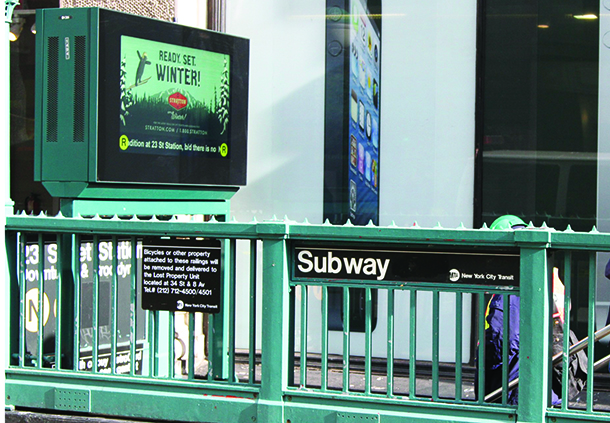
New York City has hired two companies to install 90 47-inch On The Go interactive maps later this year. The On The Go kiosks can help subway users find their way and displays useful information such as delays, outages, ads and the weather forecast. They will soon be seen outside pay machine areas, inside mezzanines and on subway platforms.
“With On the Go, we are adding yet another layer of state-of-the-art customer communications into our subway system, but it goes far beyond the already helpful information provided by our countdown clocks and the displays in our new technology subway cars,” said MTA NYC Transit President Thomas Prendergast in a press release.
Each kiosk will show subway users how to get from one station to another. To access information, users tap their destination and the kiosks display the best route. It will also feature tourist highlights. For example, the map might offer the Empire State Building and directions to the 34th Street-Herald Square subway station.
For those who complain they have no cell phone service at subway stations, these new devices will offer Wi-Fi. Security cameras will use the connection to communicate through kiosks and the MTA will use them to see what’s happening.
Each kiosk will be built into stainless steel with a functional temperature of up to 200 degrees. They will be able to withstand the city’s hottest summer days in the subway, which can reach up to 120 degrees. It is estimated that the cost of each kiosk will be under $15,000.
A few of the devices were put to the test in September 2011 with successful feedback. The original kiosks, designed by Antenna Design NY Inc., were placed in the Bowling Green, Atlantic Avenue-Barclays Center and Jackson Heights-Roosevelt Avenue subway stations as well as Pennsylvania Station and Grand Central Terminal.
“Taken together, this is an unprecedented amount of information made available to subway and commuter rail customers. These state-of-the-art customer communications kiosks provide instant information that makes using the transit system more efficient,” said Prendergast in the press release.
“The kiosks could be beneficial during natural disasters like Hurricane Sandy, with information able to reach people within seconds,” Colin O’Donnell, a founding partner at Control Group – one of the companies installing the kiosks – said, “NYC serves people of all abilities, physical and financial. Even though as much as 60 percent of the population has a mobile phone, it’s really not fair to have that as a requirement to navigating the city.”
Josh Kramb, 39, of Kingston, N.Y., often comes to the city for business and admits that he got lost the first time he used the subway system.
“I would probably use those [kiosks],” he said. “A lot of the signage down there is pretty confusing.”
Additional reporting by Andrew Karpan. Georgia Dudman is a contributing writer. Email her at [email protected]






















































































































































